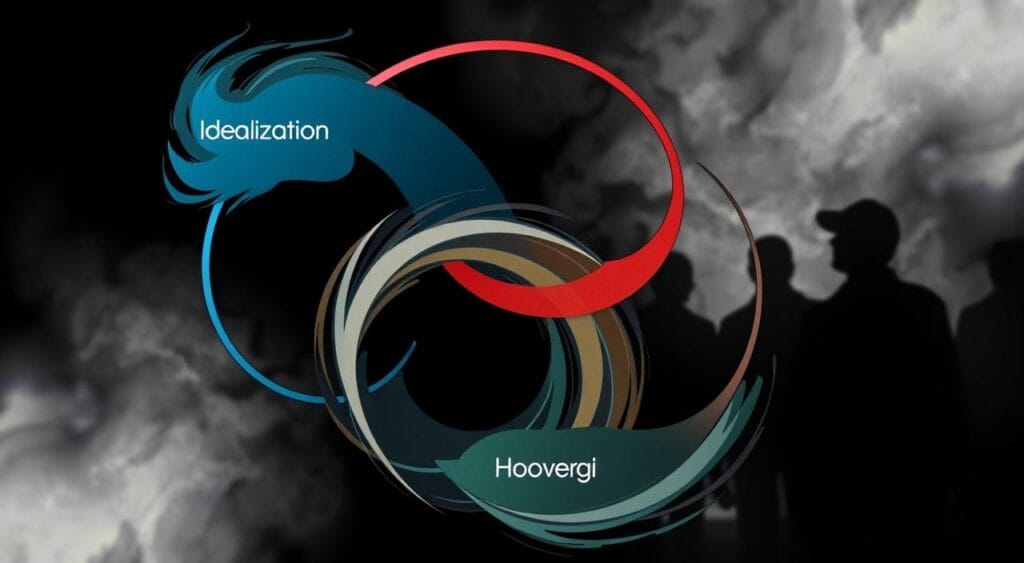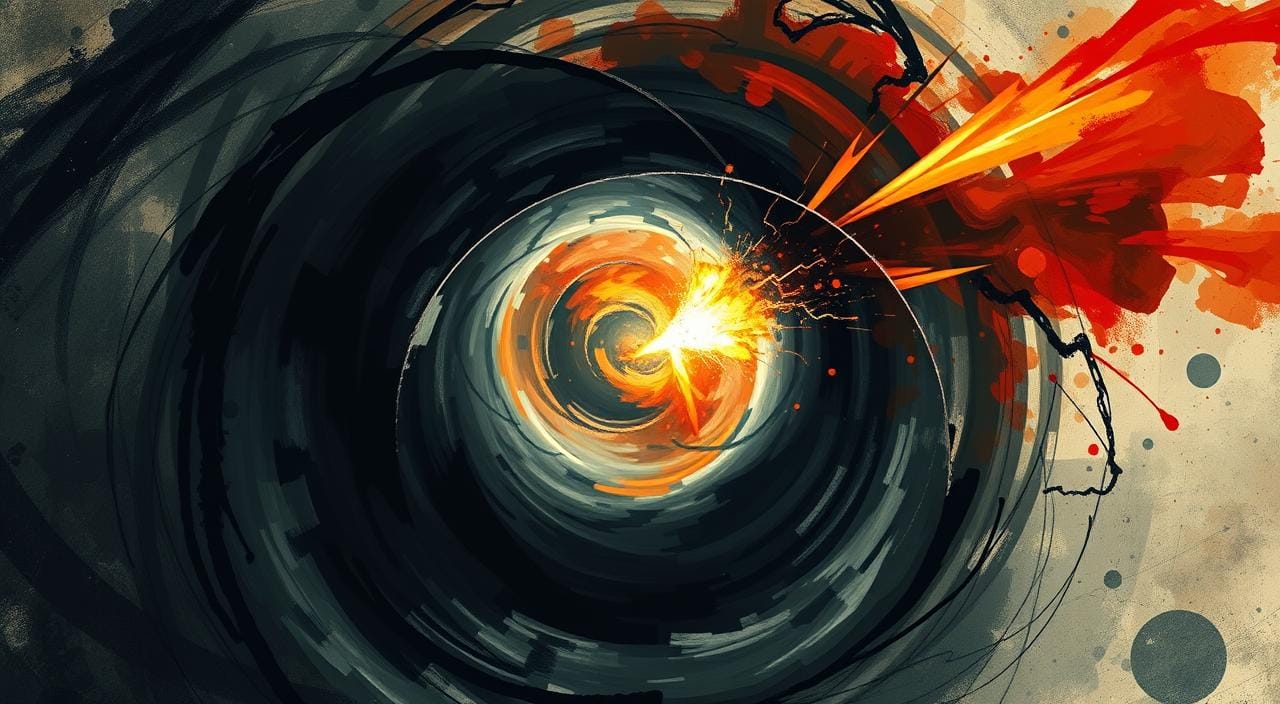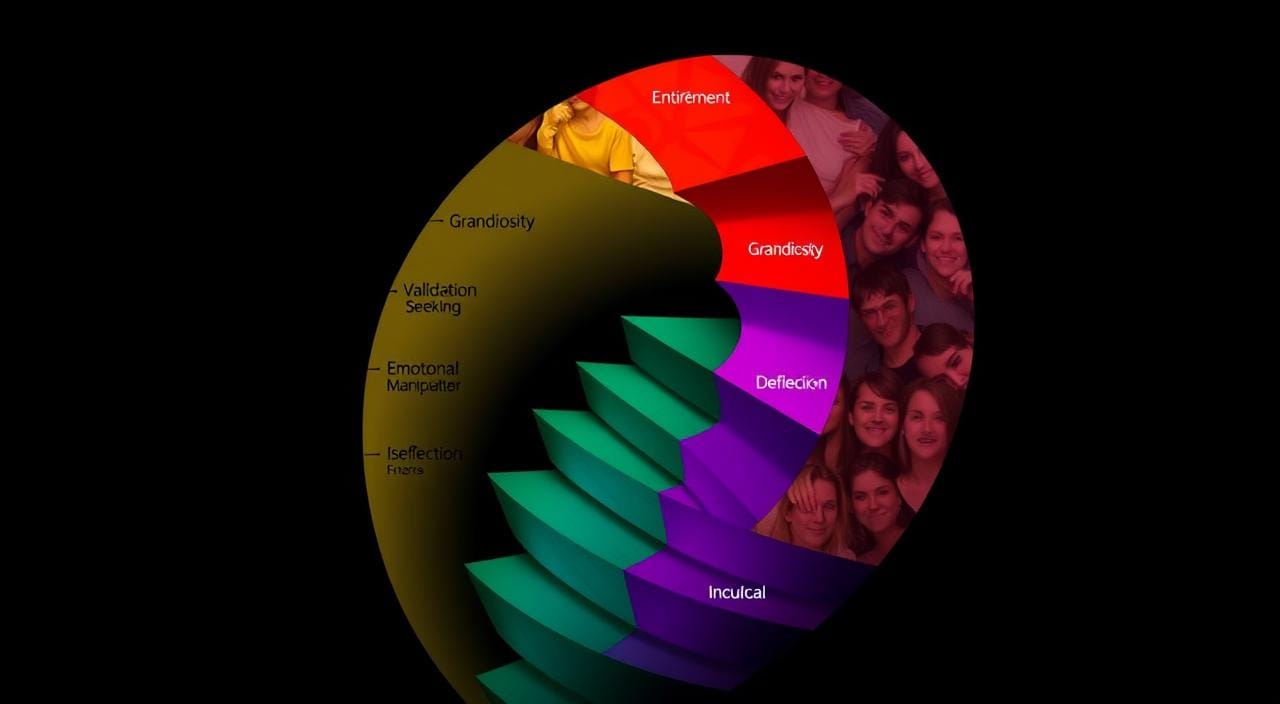Human relationships can sometimes hide a dark side – narcissistic abuse. This emotional manipulation can deeply hurt us, making us feel lost and unsure of who we are1. In this article i will discuss, Narcissistic Abuse Cycle Examples.
Ever felt a rush of love, only to be ignored or even attacked? This is what narcissistic abuse looks like. It’s a cycle of being idealized, then devalued and discarded, leaving us feeling lost and powerless1.
In this article, we’ll look at the signs of narcissistic abuse. We’ll help you spot the warning signs and find a way out. We’ll talk about how narcissists use love-bombing, gaslighting, and other tactics to control us. By understanding these patterns, we can start to heal and take back our lives.
Key Takeaways
- The narcissistic abuse cycle follows a distinct pattern of idealization, devaluation, and discarding.
- 1Narcissistic abusers often use manipulation tactics like love-bombing and gaslighting to gain control.
- 2Narcissistic abuse can lead to long-term psychological effects, including depression, anxiety, and feelings of worthlessness.
- 1Narcissistic abusers frequently ignore boundaries, engage in constant criticism, and shift blame onto their victims.
- Understanding the patterns of narcissistic abuse is key to breaking free from the cycle of emotional turmoil.
What is Narcissistic Abuse?
Narcissistic abuse is a form of emotional abuse. It is done by people with narcissistic traits or narcissistic personality disorder (NPD)3. These individuals think they are more important than others and expect special treatment. They also don’t care about how others feel3.
This abuse can cause a lot of harm. Victims might feel anxious, depressed, and isolated4. They may doubt their own thoughts and feel trapped in the relationship4.
Narcissistic abusers use tricks like gaslighting and financial control. They insult and threaten to keep their victims in line3. It’s important to know the signs of narcissistic abuse to protect oneself and get help3.
Knowing the patterns of narcissistic abuse is key. It helps identify and stop emotional mistreatment4. Victims can regain their well-being by staying financially independent and seeking support from loved ones4.
“Narcissistic abuse is a form of emotional abuse that can have devastating consequences on the victim’s mental and emotional well-being.”
Narcissistic abuse is complex and harmful. It needs special support to overcome5. Learning about its signs and patterns helps victims get the help they need and escape the abuse5.
Emotional Abuse by Narcissists
Narcissistic abuse is psychological and emotional manipulation. It’s done by people with narcissistic traits or NPD5. These individuals believe they are superior and have no empathy5.
Victims suffer from depression, anxiety, and low self-esteem5. But, with the right support, they can break free from narcissistic abuse345.
Signs of Narcissistic Abuse
Narcissistic personality disorder (NPD) makes people need admiration a lot and not care about others6. This can make the victim feel alone and lose their self-confidence. It’s important to know the signs of narcissistic abuse to protect ourselves and our loved ones.
Emotional Manipulation Tactics
Signs of narcissistic abuse include love-bombing, gaslighting, ignoring boundaries, projecting, nitpicking, and shifting blame6. These actions help the narcissist control the victim, making them feel unsure and anxious.
- Gaslighting and manipulation make victims doubt their own experiences, focusing more on the abuser’s feelings6.
- Isolation is a common tactic, pulling victims away from their support system6.
- Rapidly getting close to someone is a sign of potential narcissistic abuse6.
The abuse cycle includes idealization, devaluation, and rejection, hurting and confusing the victim6.
Narcissistic abuse can harm a victim’s mental health, causing shame, anxiety, and low self-esteem6. Getting help from a mental health expert is key to dealing with the abuse, setting boundaries, and recovering6.

“Narcissistic abuse often involves emotional abuse, such as aggression in the ‘devalue’ stage of the cycle.”7
It’s vital to recognize the signs of narcissistic abuse to escape these toxic relationships and regain our self-worth6. By learning and seeking help, we can move past narcissistic abuse and find better relationships.
Narcissistic Abuse Cycle Examples
Narcissistic abuse can take many forms. This includes withholding, emotional blackmail, insults, malicious gossip, sabotage, and false accusations1. These tactics aim to lower the victim’s self-esteem and keep the abuser in control.
Withholding is a common tactic. The abuser might not give money, affection, or talk to punish the victim1. Emotional blackmail uses the victim’s feelings to make them feel guilty or scared1.
Verbal abuse, like name-calling and harsh criticism, is also common1. It’s used to make the victim feel worthless. Malicious gossip can hurt the victim’s reputation and isolate them1.
Sabotage is another tactic. The abuser might harm the victim’s career, relationships, or other life areas to control them1. False accusations, like lying or cheating, are used to make the victim defensive1.
These behaviors are part of a larger cycle of narcissistic abuse. It involves idealizing, devaluing, and discarding the victim8. Knowing these patterns is key for victims to escape and start healing.

“Narcissistic abuse often involves difficulty in maintaining relationships across various life areas such as home, work, and community.”3
Understanding The Cycle of Narcissistic Abuse
Narcissistic abuse is a cycle that traps victims in emotional turmoil8. It has three main phases: idealization, devaluation, and discarding8.
In the idealization phase, the narcissist shows a perfect image of themselves. They shower the victim with charm and affection to win them over8. This makes the victim trust and depend on the narcissist9.
As the relationship grows, the narcissist starts to criticize the victim in the devaluation phase. They use gaslighting to lower the victim’s self-esteem89. Victims may lose friends, face personal attacks, and see an increase in substance abuse8.
In the discarding phase, the narcissist may suddenly end the relationship or become distant. This leaves the victim feeling worthless and broken8. The narcissist might also spread rumors about the victim after the breakup9.
Knowing about the narcissistic abuse cycle helps spot the signs of abuse10. Being aware of these patterns lets people recognize the narcissist’s tricks. It also helps them find support to escape the emotional abuse109.

“The narcissistic abuse cycle follows a distinct and cyclical pattern that can trap victims in a continuous loop of emotional turmoil.”
Narcissistic Abuse Cycle Examples:
It’s key to know the narcissistic abuse cycle to spot and stop harmful patterns in toxic relationships. This cycle has three main parts: idealization, devaluation, and discarding11.
The Idealization Phase
In the idealization phase, the narcissist shows a perfect image of themselves. They use charm, empathy, and affection to attract the victim. This stage is filled with too much attention, flattery, and seeming perfection12.
The Devaluation Phase
As the relationship goes on, the narcissist starts to criticize instead of adore. They lower the victim’s self-esteem, question their reality, and push their boundaries. This creates a world of constant doubt and criticism11.
The Discarding Phase
In the discarding phase, the narcissist might suddenly end the relationship or become cold. The victim feels worthless and broken. This cycle can keep going, causing endless emotional pain11.

Knowing the signs of this cycle is crucial. Look out for odd behavior, crossing boundaries, and needing constant praise. This helps protect you from narcissistic abuse12.
“The narcissistic abuse cycle follows a distinct pattern consisting of three key phases: idealization, devaluation, and discarding.”
Healing from narcissistic abuse is possible with the right help and understanding. Breaking free from this cycle helps you find your self-worth again. You can move towards a better, more fulfilling life11.
Effects of Narcissistic Abuse
Narcissistic abuse deeply affects a person’s mental, emotional, and physical health13. It can cause anxiety, depression, and make someone feel worthless13. It also leads to social isolation and trouble forming healthy relationships13.
People who have been abused find it hard to trust others and set boundaries13. They also struggle with communication13. This abuse can lead to mental health issues like anxiety, depression, and PTSD13.
In severe cases, it can affect daily life, impacting work and relationships13. It can also make someone feel isolated and even lead to suicidal thoughts13. Children who experience this abuse may have trouble forming healthy relationships as adults13.
It’s hard for victims to recognize narcissistic abuse because of the abuser’s manipulative ways13. They might feel they deserve the abuse or blame themselves13. To heal, they need therapy, to set boundaries, practice self-care, and build a support network13.
Seeing a therapist who knows about trauma and narcissistic abuse can help13. They can learn to cope and deal with the trauma13. It’s also important to set boundaries, take care of oneself, and build supportive relationships13.
“The effects of narcissistic abuse can be devastating, leading to long-lasting impacts on an individual’s mental, emotional, and physical well-being. However, with the right support and coping strategies, recovery is possible.”
Narcissistic abuse can take many forms, like emotional, financial, and verbal abuse13. It deeply affects a person’s well-being13. People with narcissistic personality disorder have a grandiose sense of self and lack empathy3.
A study from 2017 shows that those with NPD may do well in short-term relationships but struggle in long-term ones3. A 2019 study found that narcissistic abuse can sometimes be fatal, showing its severe effects3.
Research by Sophie Kjærvik and Brad Bushman found that those with narcissistic traits are more aggressive and violent7. The cycle of abuse includes idealizing, devaluing, and discarding7. The American Psychiatric Association lists nine criteria for NPD, which must be met by early adulthood7.
Effects of narcissistic abuse can cause depression, anxiety, PTSD, and more7. Survivors may experience Narcissistic Abuse Syndrome, though it’s not an official disorder7. Charlie Health offers support for young people with severe mental health issues from abuse, including a virtual IOP7.
The effects of narcissistic abuse can be severe, affecting mental, emotional, and physical health13. But, with the right help and strategies, recovery is possible13.
Narcissistic Abuse Recovery: Challenges and Treatment
The 4 Stages of the Abuse Cycle
The narcissistic abuse cycle is a pattern of abuse that many with narcissistic personality disorder (NPD) use on their partners. This cycle goes through four stages: idealization, devaluation, discard, and hoover. Research shows that the narcissist first idealizes their partner, giving them lots of attention and validation to gain trust14. But, this phase quickly turns into devaluation, where the narcissist starts to manipulate and lower their partner’s self-worth1415.
In the devaluation stage, the narcissist may use emotional outbursts, verbal abuse, and controlling behaviors to show their power16. Once they’ve lowered their partner’s self-esteem, they might suddenly discard them. They often try to ruin the relationship and isolate their partner1415.
The cycle doesn’t stop there. The narcissist might try to “hoover” their former partner back, using tricks like love-bombing, gaslighting, and false promises of change15. This use of intermittent reinforcement makes it hard for the victim to escape the abuse14.

It’s important to know the stages of the narcissistic abuse cycle for those who have been through it. Understanding the manipulation and control helps them protect their emotional health. It also helps them find the support they need to heal16.
Signs of Emotional Abuse
Emotional abuse is not as easy to spot as physical abuse. People with narcissistic traits or Narcissistic Personality Disorder3 often hide their abuse. They make it hard for victims to see what’s happening. Here are some signs of emotional abuse:
- Constant criticism and put-downs
- Mixed messages, such as “I love you” followed by belittling remarks
- An atmosphere of fear and intimidation
- Gaslighting, or denying or distorting reality
- Isolation from friends, family, and support systems
- Controlling behaviors, such as restricting access to resources or information
- Threats, intimidation, or punishment
- Blame-shifting and failure to take responsibility
- Withholding affection or emotional support
These actions erode a person’s self-confidence and reality. Narcissistic individuals may excel in short-term relationships but struggle in long-term ones7. They focus more on their own needs than their partner’s.
Knowing the signs of emotional abuse, characteristics of emotional abuse, and identifying emotional manipulation is key. It helps protect oneself or a loved one from narcissistic abuse3. Long-term abuse can lead to mental health issues like depression, anxiety, or PTSD7.
Understanding the narcissistic abuse cycle and being wary of intense affection can help. Documenting interactions with potential manipulators is also useful. This can help victims deal with gaslighting, a common tactic3.
| Narcissistic Abuse Cycle Stages | Characteristics |
|---|---|
| Idealization | Excessive flattery, grandiose promises, and intense displays of affection to win over the target |
| Devaluation | Criticism, belittling, and emotional manipulation to undermine the victim’s self-worth |
| Discarding | Abandonment, neglect, or abrupt termination of the relationship, often with no explanation |
Being aware of the signs of emotional abuse, characteristics of emotional abuse, and identifying emotional manipulation empowers people. It helps them recognize and address this harmful mistreatment37.
“Recognizing the signs of the narcissistic abuse cycle and understanding how to handle it can be vital in safeguarding against detrimental psychological impacts.”
Narcissistic Relationship Patterns
Relationships with narcissists often follow distinct patterns that can be extremely damaging. According to experts, seven key narcissistic relationship patterns to watch out for include:
- Love bombing – the narcissist showers the victim with intense affection and admiration to lure them in9.
- Manipulation and gaslighting – the narcissist denies reality and makes the victim question themselves, putting them in a position of power9.
- Triangulation – the narcissist brings in a third party to undermine the victim and maintain control9.
- Excessive self-praise – the narcissist constantly boasts about their own achievements and superiority9.
- Lack of accountability – the narcissist blames the victim for their own abusive behaviors9.
- Lack of empathy – the narcissist shows little to no concern for the emotional needs and well-being of their partner9.
- Avoidance of conversations – the narcissist refuses to engage in meaningful discussions or take responsibility for their actions9.
These tactics are used by narcissists to maintain control and exploit the emotional vulnerabilities of their partners. Understanding these common narcissistic relationship patterns can help individuals recognize the signs of abuse and protect themselves9.
“The cycle of narcissistic abuse typically involves four stages: idealization, devaluation, discard, and hoover. Perpetrators often engage in future faking, love bombing, mirroring, and pathological lying to manipulate their victims.”
Narcissists may use a variety of emotional abuse tactics, such as control, stonewalling, triangulation, isolation, flying monkeys, discard phase, smear campaigns, hoovering, and blame-shifting, to maintain power over their partners9. The overarching goal is often to assert control and fulfill their own narcissistic needs8.
Breaking free from the cycle of narcissistic abuse can be challenging due to the manipulative nature of the abuser5. However, understanding these patterns and seeking support can help individuals regain their sense of self-worth and reclaim their lives5.
Impacts of Narcissistic Relationships
Being in a relationship with a narcissist can deeply affect your mental and physical health. Victims often struggle to understand their experience. They may face symptoms like post-traumatic stress disorder, depression, and anxiety1.
The emotional manipulation and gaslighting by narcissists can make victims feel isolated and confused. This abuse is a form of emotional harm caused by those who crave admiration and use manipulative tactics1.
Getting out of a narcissistic abuse cycle is hard but possible with the right support. It’s important to recognize the signs of abuse and seek help. Resources like Balance Luxury Rehab can be key in the healing journey1. Understanding the effects of narcissistic relationships helps us and others to move forward7.
FAQ
What is narcissistic abuse?
Narcissistic abuse is a form of emotional abuse. It’s done by people with narcissistic traits or narcissistic personality disorder (NPD). They often lack empathy and crave admiration, leading to harmful behaviors.
What are the signs of narcissistic abuse?
Signs include love-bombing and gaslighting. They also ignore boundaries and project their own flaws. Other signs are nitpicking, shifting blame, and creating uncertainty.
Can you provide examples of narcissistic abuse?
Examples include withholding affection and emotional blackmail. Insults, malicious gossip, sabotage, and false accusations are also common.
Can you explain the cycle of narcissistic abuse?
The cycle has three phases: idealization, devaluation, and discarding. Each phase is part of the abuse pattern.
What are the effects of narcissistic abuse?
It can cause anxiety, depression, and social isolation. It also makes people feel worthless.
Can you describe the stages of the narcissistic abuse cycle?
The cycle has four stages. First, tension builds. Then, the abuser explodes. Next, they reconcile. Finally, a calm period follows before it starts again.
What are the signs of emotional abuse?
Signs include constant criticism and mixed messages. It also creates an atmosphere of fear and gaslighting. Other signs are isolation, controlling behavior, threats, and withholding affection.
What are some common narcissistic relationship patterns?
Watch out for love bombing and manipulation. Also, triangulation, excessive self-praise, and lack of accountability are signs. Lack of empathy and avoiding conversations are also red flags.
What are the impacts of being in a narcissistic relationship?
Being with a narcissist can harm your mental and physical health. It can lead to PTSD, depression, low self-esteem, anxiety, and even dissociation.
Source Links
- Narcissistic Abuse: Examples, Signs, and Effects — Talkspace – https://www.talkspace.com/mental-health/conditions/articles/narcissistic-abuse/
- The 15 Signs Of Narcissistic Abuse, Effects, & Recovery – https://welevelupwa.com/mental-health/narcissistic-abuse/
- How to Escape a Narcissistic Abuse Cycle – https://www.verywellmind.com/narcissistic-abuse-cycle-stages-impact-and-coping-6363187
- Understanding Narcissistic Abuse Examples, Signs, And Effects – https://www.lifebulb.com/blogs/narcissistic-abuse
- Narcissistic Abuse Cycle: Definition, Stages, and Coping – https://psychcentral.com/disorders/the-narcissistic-cycle-of-abuse
- How to Recognize Narcissistic Abuse – https://www.verywellhealth.com/narcissistic-abuse-5220194
- The Narcissistic Abuse Cycle | Charlie Health – https://www.charliehealth.com/post/signs-symptoms-and-the-narcissistic-abuse-cycle
- The Cycle of Narcissistic Abuse – https://www.narcissisticabuserehab.com/cycle-of-narcissistic-abuse/
- Stages of a Narcissistic Relationship: The Cycle of Abuse – https://www.simplypsychology.org/stages-of-a-narcissistic-relationship.html
- The Narcissistic Cycle of Abuse – https://www.psychologytoday.com/intl/blog/love-in-the-age-narcissism/202203/the-narcissistic-cycle-abuse
- What is a Narcissistic Abuse Cycle & How Does It Work – https://www.marriage.com/advice/mental-health/narcissistic-abuse-cycle/
- Narcissist Love Bombing Cycle: Recognize and Protect Yourself – https://thebetteryouinstitute.com/2021/04/01/love-bombing-the-narcissistic-abuse-cycle/
- Long-Term Effects of Narcissistic Abuse | Charlie Health – https://www.charliehealth.com/post/the-long-term-effects-of-narcissistic-abuse
- The 4 Critical Steps of a Narcissist’s Invasion – https://www.psychologytoday.com/us/blog/peaceful-parenting/202112/the-4-critical-steps-narcissists-invasion
- These Are The 4 Stages Of A Relationship With A Narcissist, According To Experts – https://www.mindbodygreen.com/articles/narcissistic-relationship-pattern
- The 4 Stages of the Cycle of Abuse: From Tension to Calm and Back – https://psychcentral.com/health/cycle-of-abuse







